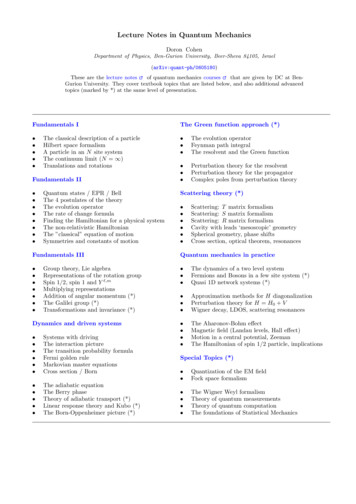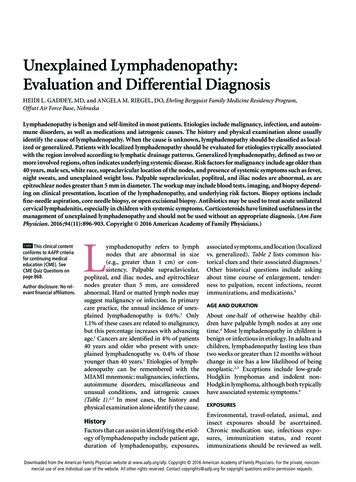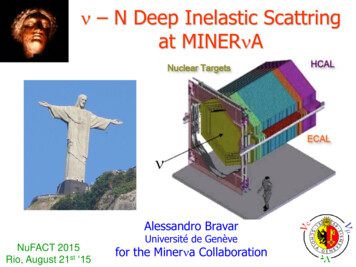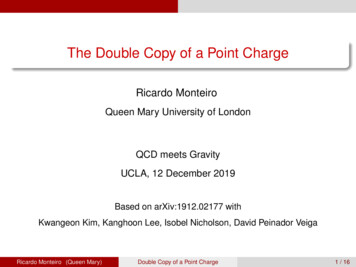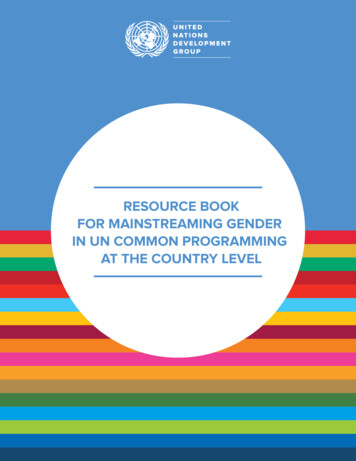![ArXiv:2106.03048v1 [cs.CL] 6 Jun 2021](/img/28/iggy21.jpg)
Transcription
How Did This Get Funded?!Automatically Identifying Quirky Scientific AchievementsChen Shani , Nadav Borenstein , Dafna ShahafThe Hebrew University of Jerusalem{chenxshani, nadav.borenstein, dshahaf}@cs.huji.ac.ilarXiv:2106.03048v1 [cs.CL] 6 Jun 2021AbstractHumor is an important social phenomenon,serving complex social and psychologicalfunctions. However, despite being studied formillennia humor is computationally not wellunderstood, often considered an AI-completeproblem.In this work, we introduce a novel setting inhumor mining: automatically detecting funnyand unusual scientific papers. We are inspiredby the Ig Nobel prize, a satirical prize awardedannually to celebrate funny scientific achievements (example past winner: “Are cows morelikely to lie down the longer they stand?”).This challenging task has unique characteristics that make it particularly suitable for automatic learning.We construct a dataset containing thousandsof funny papers and use it to learn classifiers,combining findings from psychology and linguistics with recent advances in NLP. We useour models to identify potentially funny papersin a large dataset of over 630,000 articles. Theresults demonstrate the potential of our methods, and more broadly the utility of integrating state-of-the-art NLP methods with insightsfrom more traditional disciplines.1IntroductionHumor is an important aspect of the way we interact with each other, serving complex social functions (Martineau, 1972). Humor can function eitheras a lubricant or as an abrasive: it can be used as akey for improving interpersonal relations and building trust (Wanzer et al., 1996; Wen et al., 2015), orhelp us work through difficult topics. It can also aidin breaking taboos and holding power to account.Enhancing the humor capabilities of computers hastremendous potential to better understand interactions between people, as well as build more naturalhuman-computer interfaces. Equal contributionNevertheless, computational humor remains along-standing challenge in AI; It requires complexlanguage understanding, manipulation capabilities,creativity, common sense, and empathy. Some evenclaim that computational humor is an AI-completeproblem (Stock and Strapparava, 2002).As humor is a broad phenomenon, most workson computational humor focus on specific humortypes, such as knock-knock jokes or one-liners (Mihalcea and Strapparava, 2006; Taylor and Mazlack,2004). In this work, we present a novel humorrecognition task: identifying quirky, funny scientific contributions. We are inspired by the Ig Nobelprize1 , a satiric prize awarded annually to ten scientific achievements that “first make people laugh,and then think”. Past Ig Nobel winners include“Chickens prefer beautiful humans” and “Beautyis in the eye of the beer holder: People who thinkthey are drunk also think they are attractive”.Automatically identifying candidates for the IgNobel prize provides a unique perspective on humor. Unlike most humor recognition tasks, thehumor involved is sophisticated, and requires common sense, as well as specialized knowledge andunderstanding of the scientific culture. On the otherhand, this task has several characteristics renderingit attractive: the funniness of the paper can oftenbe recognized from its title alone, which is short,with simple syntax and no complex narrative structure (as opposed to longer jokes). Thus, this is arelatively clean setting to explore our methods.We believe humor in science is also particularlyinteresting to explore, as humor is strongly tied tocreativity. Quirky contributions could sometimesindicate fresh perspectives and pioneering attemptsto expand the frontiers of science. For example,Andre Geim won an Ig Nobel in 2000 for levitatinga frog using magnets and a Nobel Prize in Physics1improbable.com/ig-about
in 2010. The Nobel committee explicitly attributedthe win to his playfulness (The Royal SwedishAcademy of Science, 2010).Our contributions are: We formulate a novel humor recognition taskin the scientific domain. We construct a dataset containing thousandsof funny scientific papers. We develop multiple classifiers, combiningfindings from psychology and linguistics withrecent NLP advances. We evaluate them bothon our dataset and in a real-world setting, identifying potential Ig Nobel candidates in a largecorpus of over 0.6M papers. We devise a rigorous, data-driven way to aggregate crowd workers’ annotations for subjective questions. We release data and code2 .Beyond the tongue-in-cheek nature of our application, we more broadly wish to promote combining data-driven research with more-traditionalworks in areas such as psychology. We believe insights from such fields could complement machinelearning models, improving performance as wellas enriching our understanding of the problem.2Related WorkHumor in the Humanities. A large body of theoretical work on humor stems from linguistics andpsychology. Ruch (1992) divided humor into threecategories: incongruity, sexual, and nonsense (andcreated a three-dimensional humor test to accountfor them). Since our task is to detect humor inscientific contributions, we believe that the thirdcategory can be neglected under the assumptionthat no-nonsense article would (or at least, should)be published (notable exception: the Sokal hoax(Sokal, 1996)).The first category, incongruity, was first fullyconceptualized by Kant in the eighteenth century(Shaw, 2010). The well-agreed extensions to incongruity theory are the linguistics incongruity resolution model and semantic script theory of humor(Suls, 1972; Raskin, 1985). Both state that if asituation ended in a manner that contradicted ourprediction (in our case, the title contains an unexpected term) and there exists a different, less likelyrule to explain it – the result is a humorous experience. Simply put, the source of humor lies in2github.com/nadavborenstein/Iggyviolation of expectations. Example Ig Nobel winners include: “Will humans swim faster or slowerin syrup?” and ”Coordination modes in the multisegmental dynamics of hula hooping”.The second category, sex-related humor is alsocommon among Ig Nobel winning papers. Examples include: “Effect of different types of textileson sexual activity. Experimental study” and “Magnetic resonance imaging of male and female genitals during coitus and female sexual arousal”.Humor Detection in AI. Most computational humor detection work done in the context of AI relieson supervised or semi-supervised methods and focuses on specific, narrow, types of jokes or humor.Humor detection is usually formulated as a binary text classification problem. Example domainsinclude knock-knock jokes (Taylor and Mazlack,2004), one-liners (Miller et al., 2017; Simpsonet al., 2019; Liu et al., 2018; Mihalcea and Strapparava, 2005; Blinov et al., 2019; Mihalcea and Strapparava, 2006), humorous tweets (Maronikolakiset al., 2020; Donahue et al., 2017; Ortega-Buenoet al., 2018; Zhang and Liu, 2014), humorous product reviews (Ziser et al., 2020; Reyes and Rosso,2012), TV sitcoms (Bertero and Fung, 2016), shortstories (Wilmot and Keller, 2020), cartoons captions (Shahaf et al., 2015), and even “That’s whatshe said” jokes (Hossain et al., 2017; Kiddon andBrun, 2011). Related tasks such as irony, sarcasmand satire have also been explored in similarly narrow domains (Davidov et al., 2010; Reyes et al.,2012; Ptáček et al., 2014).3Problem Formulation and DatasetOur goal in this paper is to automatically identifycandidates for the Ig Nobel prize. More precisely,to automatically detect humor in scientific papers.First, we consider the question of input to ouralgorithm. Sagi and Yechiam (2008) found a strongcorrelation between funny title and humorous subject in scientific papers. Motivated by this correlation, we manually inspected a subset of Ig Nobelwinners. For the vast majority of them, reading thetitle was enough to determine whether it is funny;very rarely did we need to read the abstract, letalone the full paper. Typical past winners’ titles include “Why do old men have big ears?” and “If youdrop it, should you eat it? Scientists weigh in on the5-second rule”. An example of a non-informativetitle is “Pouring flows”, a paper calculating theoptimal way to dunk a biscuit in a cup of tea.
Based on this observation, we decided to focuson the papers’ titles. More formally: Given a title tof an article, our goal is to learn a binary functionϕ(t) {0, 1}, reflecting whether the paper is humorous, or ‘Ig Nobel-worthy’. The main challenge,of course, lies in the construction of ϕ.To take a data-driven approach to tackle thisproblem, we crafted a first-of-its-kind dataset containing titles of funny scientific papers2 . We startedfrom the 211 Ig Nobel winners. Next, we manuallycollected humorous papers from online forums andblogs3 , resulting in 1,707 papers. We manuallyverified all of these papers can be used as positiveexamples. In Section 6 we give more indicationthese papers are indeed useful for our task.For negative examples, we randomly sampled1,707 titles from Semantic Scholar4 (to obtain abalanced dataset). We then classify each paper intoone of the following scientific fields: neuroscience,medicine, biology, or exact sciences5 . We balancedthe dataset in a per-field manner. While some ofthese randomly sampled papers could, in principle, be funny, the vast majority of scientific papersare not (we validated this assumption through sampling).4Humor-Theory Inspired FeaturesIn deep learning, architecture engineering largelytook the place of feature engineering. One of thegoals of our work is to evaluate the value of featuresinspired by domain experts. In this section, we describe and formalize 127 features implementinginsights from humor literature. To validate the predictive power of the features that require training,we divide our data to train and test sets (80%/20%).We now describe the four major feature families.4.1Unexpected LanguageResearch suggests that surprise is an importantsource of humor (Raskin, 1985; Suls, 1972). Indeed, we notice that titles of Ig Nobel winners ofteninclude an unexpected term or unusual language,e.g.: “On the rheology of cats”, “Effect of coke onsperm motility” and “Pigeons’ discrimination ofpaintings by Monet and Picasso”. To quantify unexpectedness, we create several different languagemodels (LMs):3E.g., emanticscholar.org/corpus/5Using scimagojr.com to map venues to fields.N-gram Based LMs. We train simple N-gramLMs with n {1, 2, 3} on two corpora – 630,000titles from Semantic Scholar, and 231,600 one-linejokes (Moudgil, 2016).Syntax-Based LMs. Here we test the hypothesisthat humorous text has more surprising grammatical structure (Oaks, 1994). We replace each wordin our Semantic Scholar corpus with its corresponding part-of-speech (POS) tag6 . We then trainedN-gram based LMs (n {1, 2, 3}) on this corpus.Transformer-Based LMs. We use three differentTransformers based (Vaswani et al., 2017) models: 1) BERT (Devlin et al., 2018) (pre-trained onWikipedia and the BookCorpus), 2) SciBERT (Beltagy et al., 2019), a variant of BERT optimized onscientific text from Semantic Scholar, and 3) GPT-2(Radford et al., 2019), a large Transformer-basedLM, trained on a dataset of 8M web pages. Wefine-tuned GPT-2 on our Semantic Scholar corpora(details in Appendix C.1).Using the LMs. For each word in a title, wecompute the word’s perplexity. For the N-gramLMs and GPT-2, we compute the probability to seethe word given the previous words in the sentence(n 1 previous words in the case of the N-grammodels and all the previous words in the case ofGPT-2). For the BERT-based models, we computethe masked loss of the word given the sentence. Foreach title, we computed the mean, maximum, andvariance of the perplexity across all words in thetitle.4.2Simple LanguageInspired by previous findings (Ruch, 1992;Gultchin et al., 2019), we hypothesize that titles offunny papers tend to be simpler (e.g., the past Ig Nobel winners: “Chickens prefer beautiful humans”and “Walking with coffee: Why does it spill?”).We utilize several simplicity measures:Length. Short titles and titles containing manyshort words tend to be simpler. We compute titlelength and word lengths (mean, maximum, andvariance of word lengths in the title).Readability. We use the automated readabilityindex (Smith and Senter, 1967).Age of Acquisition (AoA). A well-establishedmeasure for word’s difficulty in psychology (Brysbaert and Biemiller, 2017), denoting word’s difficulty by the age a child acquires it. We computemean, maximum and variance AoA.6Obtained using NLTK (nltk.org)
AoA and Perplexity. Many basic words canbe found in serious titles (e.g., ‘water’ in a hydraulics paper). Funny titles, however, containsimple words which are also unexpected. Thus, wecombine AoA with perplexity. We compute wordperplexity using the Semantic Scholar N-gram LMsand divide it by AoA. Higher values correspond tosimpler and unexpected words. We compute themean, maximum, minimum, and variance.4.3Crude LanguageAccording to relief theory, crude and scatologicalconnotations are often considered humorous (Shurcliff, 1968) (e.g., the Ig Nobel winners “Duration ofurination does not change with body size”, “Acutemanagement of the zipper-entrapped penis”).We trained a Naive Bayes SVM (Wang and Manning, 2012) classifier over a dataset of toxic andrude Wikipedia comments (Zafar, 2018), and compute title probability to be crude. Similar to theAoA feature, we believe that crude words shouldalso be unexpected to be considered funny. Asbefore, we divide perplexity by the word’s probability of being benign. Higher values correspondto crude and unexpected words. We compute themean, maximum, minimum, and variance.4.4Funny LanguageSome words (e.g., nincompoop, razzmatazz) are inherently funnier than others (due to various reasonssurveyed by Gultchin et al. (2019)). It is reasonable that the funniness of a title is correlated withthe funniness of its words. We measure funninessusing the model of Westbury and Hollis (2019),quantifying noun funniness based on humor theories and human ratings. We measure the funninessof each noun in a title. We also multiplied perplexity and funniness (for funny and unexpected) anduse the mean, maximum, minimum, and variance.4.5Feature ImportanceAs a first reality check, we plotted the distributionof our features between funny and not-funny papers(see Appendix A.1 for representative examples).For example, we hypothesized that titles of funnypapers might be linguistically similar to one-liners,and indeed we saw that the one-liner LM assignslower perplexity to funny papers. Similarly, wesaw a difference between the readability scores.To measure the predictive power of our literatureinspired features, we use the Wilcoxon signed-rankWilcoxonvalueUnexpected LanguageAvg. Semantic Scholar48502-gram LMAvg. POS 2-gram LM18926Avg. one-liners69192-gram LMAvg. GPT-2 LM7421Avg. BERT LM17153Simple LanguageReadability8931Title’s length18493Avg. AoA values16768Avg. AoA 48822-gram LMCrude LanguageCrudeness classifier17423Avg. crudeness 47552-gram LMFunny LanguageAvg. funny20101nouns modelAvg. funny nouns 88862-gram able 1: Wilcoxon and p-values for representative features using our dataset (tested differentiating ability between funny and serious papers). Combining perplexity with other features seems particularly beneficial.test7 (see Table 1). Interestingly, all feature familiesinclude useful features. Combining perplexity withother features (e.g., surprising and simple words)was especially prominent. In the next sections, wedescribe how we use those features to train modelsfor detecting Ig Nobel worthy papers.5ModelsWe can now create models to automatically detect scientific humor. As mentioned in Section 4,one of our goals in this paper is to compare between the NLP SOTA huge-models approach andthe literature-inspired approach. Thus, we traineda binary multi-layer perceptron (MLP) classifierusing our dataset (described in Section 3, see reproducibility details in Appendix C.2), receiving asinput the 127 features from Section 4. We namedthis classifier ‘Iggy’, after the Ig Nobel prize.7A non-parametric paired difference test used to assesswhether the mean ranks of two related samples differ.
As baselines representing the contemporary NLPapproach (requiring huge compute and trainingdata), we used BERT (Devlin et al., 2018) andSciBERT (Beltagy et al., 2019), which is a BERTvariant optimized on scientific corpora, renderingit potentially more relevant for our task. We finetuned SciBERT and BERT for Ig Nobel classification using our dataset (see Appendix C.3 for implementation details).We also experimented with two models combining BERT/SciBERT with our features (seeFigure 6 in Appendix C.4), denoted as BERTf /SciBERTf . In the spirit of the original BERT paper,we added two linear layers on top of the models andused a standard cross-entropy loss. The input tothis final MLP is the concatenation of two vectors:our features’ embedding and the last hidden vectorfrom BERT/SciBERT ([CLS]). See Appendix C.4for implementation details.For the sake of completeness, we note that wealso conducted exploratory experiments with simple syntactic baselines (title length, maximal wordlength, title containing a question, title containinga colon) as well as BERT trained on sarcasm detection8 . None of these baselines was strong enoughon its own. We note that the colon-baseline tendedto catch smart-aleck titles, but the topic was notnecessarily funny. The sarcasm baseline achievednear guess-level accuracy (0.482), emphasizing thedistinction between the two humor tasks.6Evaluation on the DatasetWe first evaluate the five models (Iggy, SciBERT,BERT, SciBERTf and BERTf ) on our labeleddataset in terms of general accuracy and Ig Nobel retrieval ability. As naive baselines, we addedtwo bag of words (BoW) based classifies: randomforest (RF) and logistic regression (LR).Accuracy. We randomly split the dataset to train,development, and test sets (80% 10% 10%), andused the development set to tune hyper-parameters(e.g., learning rate, number of training epochs).Table 2 summarizes the results. We note that allfive models achieve very high accuracy scores andthat the simple BoW models fall behind. This givessome indication about the inherent difficulty of thetask. Both features-based Iggy and BERT-basedmodels outperform simple baseline. SciBERTfoutperforms the other models across all call0.8930.9110.9260.8930.9020.7960.837Table 2: Accuracy of the different models on ourdataset using cross validation with k 5. SciBERTf 480.8820.8100.8820.7250.787Table 3: Accuracy of the different models on our IgNobel retrieval test set. The combination of SOTA pretrained models and our features is superior.Ig Nobel Winners Retrieval. Our positive examples consist of 211 Ig Nobel winners and additional1,496 humorous papers found on the web. Thus,the portion of real Ig Nobel winning papers in ourdata is relatively small. We now measure whetherour web-originated papers serve as a good proxyfor Ig Nobel winners. Thus, we split the datasetdifferently: the test set consists of the 211 Ig Nobel winners, plus a random sample of 211 negativetitles (slightly increasing the test set size to 12%).Train set consists of the remaining 2,992 papers.This experiment follows our initial inspiration offinding Ig Nobel-worthy papers, as we test our models’ ability to retrieve only the real winners.Table 3 demonstrate that our web-based funnypapers are indeed a good proxy for Ig Nobel winners. Similar to the previous experiment, the combination of SOTA pretrained models with literaturebased features is superior.Based on both experiments, we conclude that ourfeatures are indeed informative for our Ig Nobelworthy papers detection task.7Evaluation “in the Wild”Our main motivation in this work is to recommendpapers worthy of an Ig Nobel prize. In this section,
TitleThe kinematics of eating with a spoon: Bringing the food to the mouth,or the mouth to the food?Do bonobos say NO by shaking their head?Is Anakin Skywalker suffering from borderline personality disorder?Not eating like a pig: European wild boar wash their foodWhy don’t chimpanzees in Gabon crack nuts?Why do people lie online? “Because everyone lies on the internet”Which type of alcohol is easier on the gut?Rainbow connection and forbidden subgraphsA scandal of invisibility: making everyone count by counting everyoneWhere do we look when we walk on stairs? Gaze behaviour on stairs,transitions, and handrailsModelsIggy, BERTf , SciBERTfIggy, BERTf , SciBERTfIggy, BERTf , SciBERTfIggy, BERTfSciBERTf , BERTfBERTfBERTfBERTSciBERTSciBERTTable 4: A sample of top rated papers found by our models.we test our models in a more realistic setting; werun them on a large sample of scientific papers,ranking each paper according to their certainty inthe label (‘humorous’), and identifying promisingcandidates. We use the same dataset of 630k papers from Semantic Scholar used for training theLMs (Section 4). We compute funniness accordingto our models (excluding random forest and logistic regression, which performed poorly). Table 4shows examples of top-rated titles. We use theAmazon Mechanical Turk (MTurk) crowdsourcingplatform to assess models’ performance.In an exploratory study, we asked people to ratethe funniness of titles on a Likert scale of 1-5. Wenoted that people tended to confuse funny researchtopic and funny title. For example, titles like “Areyou certain about SIRT?” or “NASH may be trash”received high funniness scores, even though the research topic is not even clear from the title. Tomitigate this problem, we redesigned the studyto include two 5-point Likert scale questions: 1)whether the title is funny, and 2) whether the research topic is funny. This addition seems to indeedhelp workers understand the task better. Examplepapers rated as serious title, funny topic include“Hat-wearing patterns in spectators attending baseball games: a 10-year retrospective comparison”.Funny title, serious topic include “Slicing the psychoanalytic pie: or, shall we bake a new one? Commentary on Greenberg”. Unless stated otherwise,the evaluation in the reminder of the paper wasdone on the “funny topic” Likert scale.We paid crowd workers 0.04 per title. As thistask is challenging, we created a qualification testwith 4 titles (8 questions), allowing for one mis-take. The code for task and test can be found inthe repository2 . We also required workers to havecompleted at least 1,000 approved HITs with atleast 97% success rate.All algorithms classified and ranked (accordingto certainty) all 630k papers. However, in any reasonable use-case, only the top of the ranked list willever be examined. There is a large body of work,both in academia and industry, studying how people interact with ranked lists (in particular, searchresult pages) (Kelly and Azzopardi, 2015; Beus,2020). Many information retrieval algorithms assume the likelihood of the user examining a resultto exponentially decrease with rank. The conventional wisdom is that users rarely venture into thesecond page of search results.Thus, we posit that in our scenario of Ig Nobelrecommendations, users will be willing to read onlythe several tens of results. We choose to evaluatethe top-300 titles for each of our five models, tostudy (in addition to the performance at the topof the list) how performance decays. We also included a baseline of 300 randomly sampled titlesfrom Semantic Scholar. Altogether we evaluated1375 titles (due to overlap). Each title was rated byfive crowd workers. Overall, 13 different workerspassed our test. Seven workers annotated less than300 titles, while four annotated above 1,300 each.Decision rule. Each title was rated by five different crowd workers on a 1-5 scale. There are severalreasonable ways to aggregate these five continuousscores to a binary decision. A commonly-used aggregation method is the majority vote. The majority vote should return the clear-cut humorous titles.However, we stress that humor is very subjective
DecisionruleMin. 1annotatorMin. 2annotatorsMin. 190.150.02Labeled dataaccuracy0.840.830.820.730.780.62Table 5: Spearman correlation of MTurk annotatorswith our expert, along with accuracy of MTurk annotators on our labeled dataset for the various mappingmethods of the form “minimum (min.) k annotatorsgave a score at least m (threshold)”.(and in the case of scientific humor, quite subtle).Indeed, annotators had low agreement on the topicquestion (average pairwise Spearman ρ 0.27).Thus, we explored more aggregation methods9 .Our hypothesis class is of the general form “at leastk annotators gave a score at least m” 10 . To pickthe best rule, we conducted two exploratory experiments: In the first one, we recruited an expert scientist and thoroughly trained him on the problem. Hethen rated 90 titles and we measured the correlationof different aggregations with his ratings. Resultsare summarized in table 5: The highest-correlationaggregation is when at least one annotator crossedthe 3 threshold (Spearman ρ 0.7).In the second experiment, we used the exactsame experimental setup as the original task, butwith labeled data. We used 100 Ig Nobel winnersas positives and a random sample of 100 papers asnegatives. The idea was to see how crowd workersrate papers that we know are funny (or not). Table5 shows the accuracy of each aggregation method.Interestingly, the highest accuracy is achieved withthe same rule as in the first experiment (at least onecrossing 3). Thus, we chose this aggregation rule.We believe the method outlined in this sectioncould be more broadly applicable to aggregation ofcrowd sourced annotations for subjective questions.Results. Figure 1 shows precision at k for thetop-rated 300 titles according to each model. Therandom baseline is 0.03. Upon closer inspection,these seem to be false positives of the annotation.We have argued that in our setting it is reasonablefor users to read the first several tens of results.9For completeness, see Figure 3 in Appendix A.2.There is a long-running debate about whether it is validto average Likert scores. We believe we cannot treat the ratingsin this study as interval data.ModelIggySciBERTSciBERTfBERTBERTfPrecisionat k 500.60.570.530.440.58Precisionat k 3000.370.460.410.410.43Table 6: Precision at k of our models on the Semantic Scholar corpus for k {50, 300}. These relativelyhigh scores suggest that our models are able to identifyfunny papers.In this range, Iggy slightly outperforms the otherfour models (BERT is particularly bad, as it picksup on short, non-informative titles). For larger kvalues SciBERT and BERTf take the lead. Wenote that even at k 300, all models still achieveconsiderable (absolute) precision.We obtain similar results using normalized discounted cumulative gain (nDCG), a common measure for ranking quality (see Table 6 for nDCGscores for the top 50 and the 300 papers). Overall,these relatively high scores suggest that our modelsare able to identify funny papers.We stress that Iggy is a small and simple network( 33k parameters), compared to pretrained 110million parameters BERT-based models. Yet despite its simplicity, Iggy’s performance is roughlycomparable to BERT-based methods. We believethis demonstrates the power of implementing insights from domain experts. We hypothesize thatif the fine-tuning dataset were larger, BERTf andSciBERTf would outperform the other models.88.1AnalysisImportance of Literature-based FeaturesTaking a closer look at the actual papers in theexperiment of Section 7, the overlap between thethree feature-based models is 26 56% (for 1 k 50) and 39 62% (for 1 k 300). BERThad very low overlaps with all other models (0% intop 50, 10% in all 300). SciBERT had almost nooverlap in top 50 (maximum 2%), 10 40% in all300 (see full details in Appendix A.3). We believethis implies that the features were indeed importantand informative for both BERTf and SciBERTf .8.2Interpreting Iggy10We have seen Iggy performs surprisingly well,given its relative simplicity. In this section, we
Figure 1: Precision at k for our chosen decision rule. Iggy outperforms the other models for 0 k 50. Forlarger k, SciBERTf and BERT achieve better precision.wish to better understand the reasons. We choseto analyze Iggy with Shapely additive explanations(SHAP) (Lundberg and Lee, 2017). SHAP is a feature attribution method to explain the output of anyblack-box model, shown to be superior to more traditional feature importance methods. Importantly,SHAP provides insights both globally and locally(i.e., for specific data points).Global interpretability. We compute feature importance globally. Among top contributing featureswe see multiple features corresponding to incongruity (both alone and combined with funniness)and to word/sentence simplicity. Interestingly, features based on the one-liner jokes seem to play animportant role (See Figure 4 in Appendix A.4).Local interpretability. To understand how Iggyerrs, we examined the SHAP decision plots forfalse positives and false negatives (See Figure 5in Appendix A.4). These show the contribution ofeach feature to the final prediction for a given title,and thus can help “debugging” the model.Looking at false negatives, it appears that var
fchenxshani, nadav.borenstein, dshahafg@cs.huji.ac.il Abstract Humor is an important social phenomenon, serving complex social and psychological functions. However, despite being studied for millennia humor is computationally not well understood, often considered an AI-comple
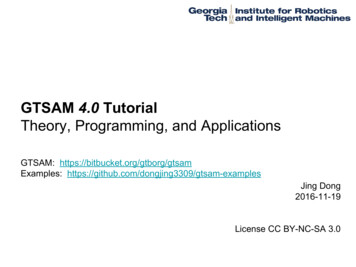
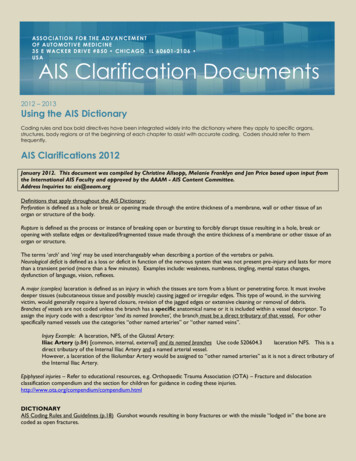


![arXiv:2104.04670v5 [cs.CL] 8 Sep 2021 - nlp.cs.berkeley.edu](/img/15/zhong-lee-zhang-klein-2021-metatuning-paper.jpg)
